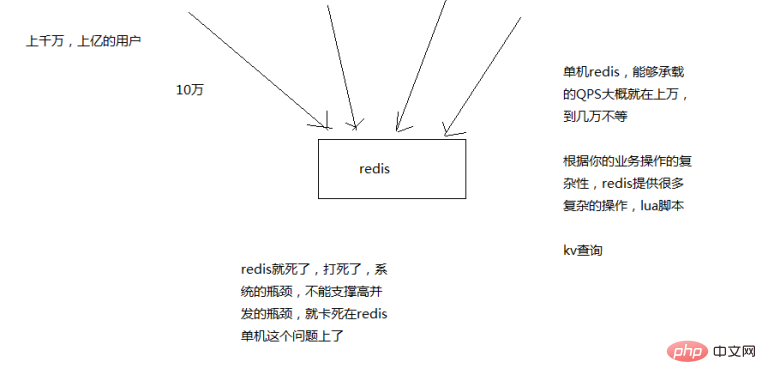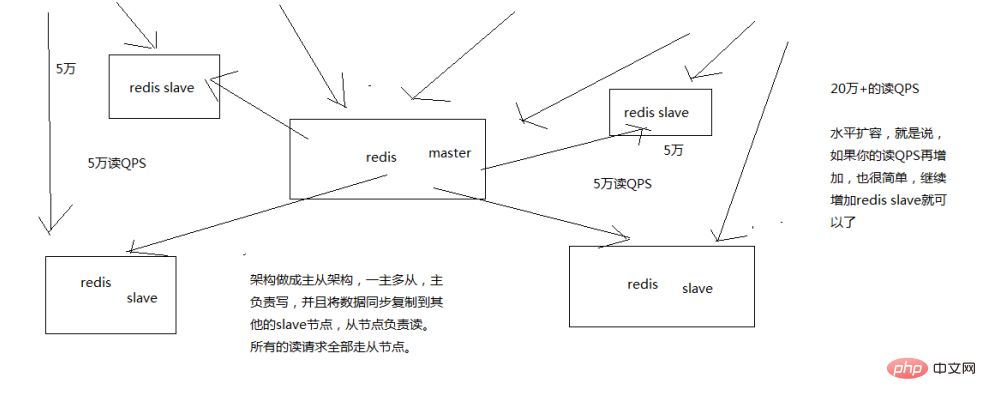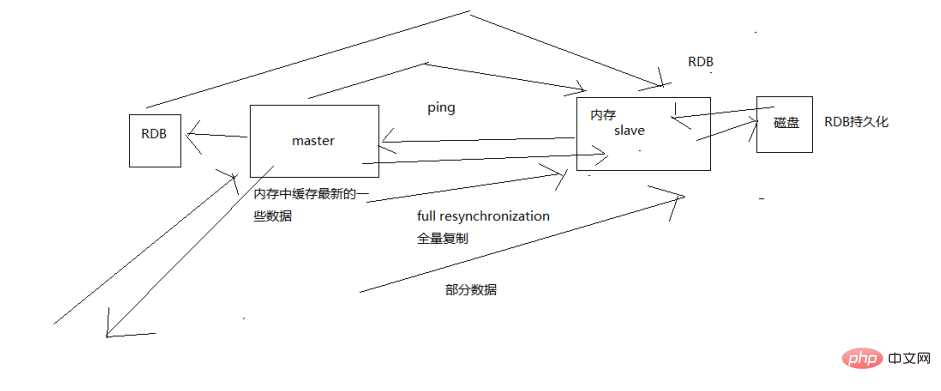Do you know how to ensure high concurrency of Redis?
The following column Redis Tutorial will introduce to you how to ensure high concurrency of Redis. I hope it will be helpful to friends in need!

It is almost impossible for a stand-alone redis to have a QPS of more than 100,000, usually in the tens of thousands.
Unless there are some special circumstances, such as your machine performance is particularly good, the configuration is particularly high, the physical machine is well maintained, and your overall operation is not too complicated.

Redis implements read-write separation through a master-slave architecture. The master node is responsible for writing and synchronizing data to other slaves. Node, the slave node is responsible for reading, thereby achieving high concurrency.
While Redis has high concurrency, it also needs to accommodate a large amount of data: one master and multiple slaves, and each instance accommodates complete data. For example, the redis master With 10G of memory, you can actually only hold 10G of data. If your cache needs to accommodate a large amount of data, reaching tens of gigabytes, or even hundreds of gigabytes, or several tons, then you need a redis cluster, and with redis cluster, you can provide hundreds of thousands of data per second. Read and write concurrently.
The core mechanism of replication
Redis uses an asynchronous method to copy data to the slave node. However, starting from redis 2.8, the slave node will periodically confirm the amount of data copied each time
A master node can be configured with multiple slave nodes
slave node You can also connect to other slave nodes
When the slave node replicates, it will not block the normal work of the master node
When the slave node replicates, It will not block its own query operations. It will use the old data set to provide services; but when the copy is completed, the old data set needs to be deleted and the new data set loaded. At this time, external services will be suspended
The slave node is mainly used for horizontal expansion and separation of reading and writing. The expanded slave node can improve the read throughput
The significance of master persistence for the security of the master-slave architecture
If a master-slave architecture is adopted, it is recommended that the persistence of the master node must be turned on!
It is not recommended to use the slave node as the data hot backup of the master node, because in that case, if you turn off the persistence of the master, the data may be empty when the master crashes and restarts. , and then the salve node data may be lost as soon as it is copied
Second, do you want to do various backup plans for the master, in case all the local files are lost; Select an rdb from the backup to restore the master; this will ensure that there is data when the master starts.

The process of master synchronizing data to slave
When starting a slave node, it will send a PSYNC command to the master node
If this is the slave node reconnecting to the master node, then the master node will only copy the missing data to the slave; otherwise, if the slave node connects to the master node for the first time, a full resynchronization will be triggered
When starting full resynchronization, the master will start a background thread and start generating an RDB snapshot file. At the same time, all write commands received from the client will be cached in memory.
After the RDB file is generated, the master will send the RDB to the slave. The slave will first write it to the local disk and then load it from the local disk into the memory. Then the master will send the write commands cached in the memory to the slave, and the slave will also synchronize the data.
If the slave node has a network failure with the master node and is disconnected, it will automatically reconnect. If the master finds that multiple slave nodes are reconnecting, it will only start an rdb save operation and use a copy of data to serve all slave nodes.
Resume the breakpoint of master-slave replication
Starting from redis 2.8, breakpoint resumption of master-slave replication is supported. If the network connection is disconnected during the master-slave replication process, you can continue the replication from the last replication point, instead of Make a copy from scratch
The master node will have a backlog in the memory. Both the master and the slave will save a replica offset and a master id. The offset is saved in the backlog.
If the network connection between the master and the slave is disconnected, the slave will let the master continue replicating from the last replica offset
But if not If the corresponding offset is found, a resynchronization will be performed
Diskless copy
The master will be directly in the memory Create rdb and then send it to the slave. The disk will not be landed locally
repl-diskless-sync
repl-diskless-sync-delay, Wait for a certain period of time before starting replication, because you have to wait for more slaves to reconnect
Expired key processing
slave The key will not expire, but will only wait for the master to expire the key.
If the master expires a key, or eliminates a key through LRU, a del command will be simulated and sent to the slave.
The complete process of replication
The slave node starts and only saves the information of the master node , including the host and IP of the master node (configured by slaveof in redis.conf), but the replication process has not started
There is a scheduled task inside the slave node, which checks whether there is new data every second The master node needs to be connected and replicated. If found, it will establish a socket network connection with the master node
The slave node sends a ping command to the master node
Password authentication, if the master If requirepass is set, then the slave node must send the masterauth password for authentication
The master node performs full replication for the first time and sends all data to the slave node
The master The node will continue to write commands and asynchronously copy them to the slave node
The core mechanism related to data synchronization
refers to That is, when the slave connects to msater for the first time, the full copy is performed. In that process, you have some detailed mechanisms
(1) Both the master and the slave will maintain an offset
The master will continuously accumulate offsets on itself, and the slave will also continuously accumulate offsets on itself
The slave will report its own offset to the master every second, and the master will also save each The offset of each slave
This does not mean that it is specifically used for full replication. The main reason is that both the master and the slave need to know the offset of their own data to know that the data between them is inconsistent. Situation
(2) backlog
The master node has a backlog, the default size is 1MB
master When the node copies data to the slave node, it will also write a copy of the data synchronously in the backlog
The backlog is mainly used for incremental copying when full replication is interrupted
(3) master run id
Info server, you can see the master run id
If you locate the master node based on the host ip, yes It’s unreliable. If the master node restarts or the data changes, the slave node should be distinguished according to different run ids. If the run ids are different, make a full copy
If you need to restart redis without changing the run id , you can use the redis-cli debug reload command
(4) psync
The slave node uses psync to copy from the master node, psync runid offset
The master node will return response information according to its own situation. It may be FULLRESYNC runid offset that triggers full copy, or CONTINUE that triggers incremental copy
Full copy
The master executes bgsave and generates an rdb snapshot file locally.
The master node sends the rdb snapshot file to the salve node. If the rdb copy time exceeds 60 seconds (repl-timeout) , then the slave node will think that the copy has failed, and you can adjust this parameter appropriately
For machines with Gigabit network cards, generally 100MB, 6G files are transferred per second, which is likely to exceed 60s
When the master node generates the rdb, it will cache all new write commands in the memory. After the salve node saves the rdb, it will copy the new write commands to the salve node
client-output-buffer-limit slave 256MB 64MB 60. If during replication, the memory buffer continues to consume more than 64MB, or exceeds 256MB at one time, then the replication will stop and the replication will fail.
The slave node receives After rdb, clear its own old data, then reload rdb into its own memory, and at the same time provide external services based on the old data version
If the slave node turns on AOF, then BGREWRITEAOF will be executed immediately. Rewrite AOF
Incremental copy
If the full copy is in progress, master- If the slave network connection is disconnected, then when the slave reconnects to the master, incremental replication will be triggered
The master directly obtains part of the lost data from its own backlog and sends it to the slave node. The default backlog is 1MB
msater is to obtain data from the backlog based on the offset in psync sent by the slave
heartbeat
The master and slave nodes will send heartbeat information to each other
The master sends a heartbeat every 10 seconds by default, and the salve node sends a heartbeat every 1 second
Asynchronous replication
Each time the master receives a write command, it now writes data internally and then sends it asynchronously to the slave node
The above is the detailed content of Do you know how to ensure high concurrency of Redis?. For more information, please follow other related articles on the PHP Chinese website!

Hot AI Tools

Undresser.AI Undress
AI-powered app for creating realistic nude photos

AI Clothes Remover
Online AI tool for removing clothes from photos.

Undress AI Tool
Undress images for free

Clothoff.io
AI clothes remover

AI Hentai Generator
Generate AI Hentai for free.

Hot Article

Hot Tools

Notepad++7.3.1
Easy-to-use and free code editor

SublimeText3 Chinese version
Chinese version, very easy to use

Zend Studio 13.0.1
Powerful PHP integrated development environment

Dreamweaver CS6
Visual web development tools

SublimeText3 Mac version
God-level code editing software (SublimeText3)

Hot Topics
 1386
1386
 52
52
 How to build the redis cluster mode
Apr 10, 2025 pm 10:15 PM
How to build the redis cluster mode
Apr 10, 2025 pm 10:15 PM
Redis cluster mode deploys Redis instances to multiple servers through sharding, improving scalability and availability. The construction steps are as follows: Create odd Redis instances with different ports; Create 3 sentinel instances, monitor Redis instances and failover; configure sentinel configuration files, add monitoring Redis instance information and failover settings; configure Redis instance configuration files, enable cluster mode and specify the cluster information file path; create nodes.conf file, containing information of each Redis instance; start the cluster, execute the create command to create a cluster and specify the number of replicas; log in to the cluster to execute the CLUSTER INFO command to verify the cluster status; make
 How to clear redis data
Apr 10, 2025 pm 10:06 PM
How to clear redis data
Apr 10, 2025 pm 10:06 PM
How to clear Redis data: Use the FLUSHALL command to clear all key values. Use the FLUSHDB command to clear the key value of the currently selected database. Use SELECT to switch databases, and then use FLUSHDB to clear multiple databases. Use the DEL command to delete a specific key. Use the redis-cli tool to clear the data.
 How to use the redis command
Apr 10, 2025 pm 08:45 PM
How to use the redis command
Apr 10, 2025 pm 08:45 PM
Using the Redis directive requires the following steps: Open the Redis client. Enter the command (verb key value). Provides the required parameters (varies from instruction to instruction). Press Enter to execute the command. Redis returns a response indicating the result of the operation (usually OK or -ERR).
 How to read redis queue
Apr 10, 2025 pm 10:12 PM
How to read redis queue
Apr 10, 2025 pm 10:12 PM
To read a queue from Redis, you need to get the queue name, read the elements using the LPOP command, and process the empty queue. The specific steps are as follows: Get the queue name: name it with the prefix of "queue:" such as "queue:my-queue". Use the LPOP command: Eject the element from the head of the queue and return its value, such as LPOP queue:my-queue. Processing empty queues: If the queue is empty, LPOP returns nil, and you can check whether the queue exists before reading the element.
 How to use redis lock
Apr 10, 2025 pm 08:39 PM
How to use redis lock
Apr 10, 2025 pm 08:39 PM
Using Redis to lock operations requires obtaining the lock through the SETNX command, and then using the EXPIRE command to set the expiration time. The specific steps are: (1) Use the SETNX command to try to set a key-value pair; (2) Use the EXPIRE command to set the expiration time for the lock; (3) Use the DEL command to delete the lock when the lock is no longer needed.
 How to read the source code of redis
Apr 10, 2025 pm 08:27 PM
How to read the source code of redis
Apr 10, 2025 pm 08:27 PM
The best way to understand Redis source code is to go step by step: get familiar with the basics of Redis. Select a specific module or function as the starting point. Start with the entry point of the module or function and view the code line by line. View the code through the function call chain. Be familiar with the underlying data structures used by Redis. Identify the algorithm used by Redis.
 How to make message middleware for redis
Apr 10, 2025 pm 07:51 PM
How to make message middleware for redis
Apr 10, 2025 pm 07:51 PM
Redis, as a message middleware, supports production-consumption models, can persist messages and ensure reliable delivery. Using Redis as the message middleware enables low latency, reliable and scalable messaging.
 How to start the server with redis
Apr 10, 2025 pm 08:12 PM
How to start the server with redis
Apr 10, 2025 pm 08:12 PM
The steps to start a Redis server include: Install Redis according to the operating system. Start the Redis service via redis-server (Linux/macOS) or redis-server.exe (Windows). Use the redis-cli ping (Linux/macOS) or redis-cli.exe ping (Windows) command to check the service status. Use a Redis client, such as redis-cli, Python, or Node.js, to access the server.




